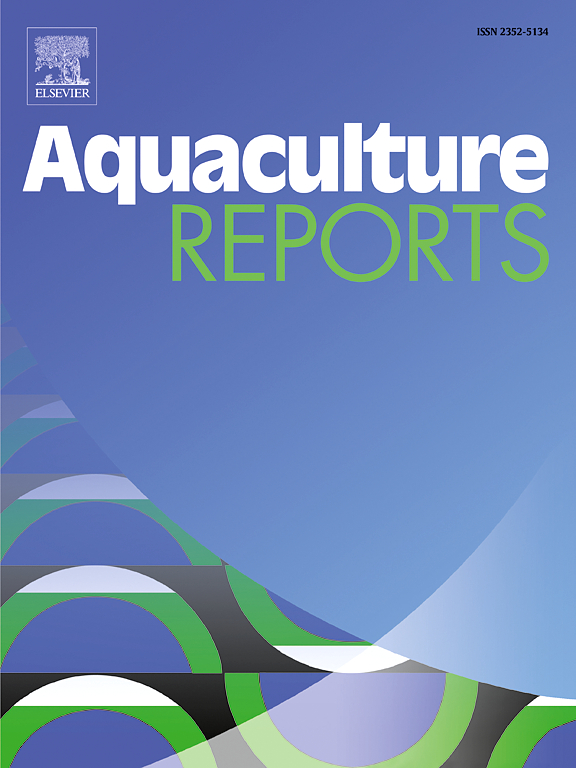Combined microbiomic and transcriptomic analysis revealed that dietary Clostridium autoethanogenum protein could improve the disease resistance of Litopenaeus vannamei by regulating the oxidative phosphorylation
IF 3.7
2区 农林科学
Q1 FISHERIES
引用次数: 0
Abstract
Clostridium autoethanogenum protein (CAP) has been demonstrated to be a good protein ingredient for replacing fish meal (FM). In this study, an 8-week feeding experiment was conducted on L. vannamei (initial weight: 0.30 ± 0.02 g) with four isonitrogenous and isolipidic diets, which were designed with CAP substitution FM levels of 0 % (CON), 15 % (CAP15), 30 % (CAP30), and 45 % (CAP45), respectively. The results showed that dietary CAP substitution for FM had no influence on the feed coefficient rate (FCR) and survival rate (SR) of L. vannamei (P > 0.05), while the final body weight (FBW), special growth rate (SGR), and weight gain rate (WGR) of L. vannamei were significantly reduced than when the replacement ratio reached 30 % (P < 0.05). After Vibrio parahaemolyticus infection, significantly higher SR of L. vannamei was found in the CAP30 and CAP45 groups compared to CON group (P < 0.05). In the CAP substitution groups, the activities of superoxide dismutase (SOD), phenoloxidase (PO) were significantly increased while the contents of malondialdehyde (MDA) were significantly decreased (P < 0.05) in the serum of L. vannamei. Analysis of the intestinal microbiota showed that dietary CAP significantly changed the alpha diversity based on the indicators including Chao1, Simpson and ACE (P < 0.05). The compositions of the microbial communities in CAP substitution groups were significantly changed at phylum, family, and genus levels when compared to the CON group (P < 0.05), for the relative abundances of Planctomycetes, Firmicutes, Dadabacteria, Rubritaleaceae, Rubinisphaeraceae and Pir4_lineage were all remarkablely changed. Transcriptomic analysis showed that most of the differentially-expressed genes (DEGs) were enriched in metabolic processes (e.g., starch and sucrose metabolism, carbon metabolism, drug metabolism), oxidative phosphorylation and disease. Combined analysis of transcriptomic and microbiomic revealed that oxidative phosphorylation pathway-related gene expression was positively correlated with Rubritaleaceae while negatively correlated with Rubinisphaeraceae. Overall, the replacement of FM by CAP could improve the growth performance and disease resistance of L. vannamei, which probably by regulating the oxidative phosphorylation and the balance of intestinal microbiota.
微生物组学和转录组学分析表明,饲粮中添加自产乙醇梭菌蛋白可以通过调节氧化磷酸化来提高凡纳滨对虾的抗病性
自产乙醇梭菌蛋白(CAP)已被证明是替代鱼粉(FM)的良好蛋白质原料。本试验对初始体重为0.30 ± 0.02 g的凡纳滨对虾(L. vannamei)进行了为期8周的等氮等脂饲料饲养试验,4种饲料的CAP替代FM水平分别为0 % (CON)、15 % (CAP15)、30 % (CAP30)和45 % (CAP45)。结果表明:饲粮中替代鱼粉对凡纳滨对虾的饲料系数率(FCR)和成活率(SR)无显著影响(P >; 0.05),但替代率达到30 %时,凡纳滨对虾的末重(FBW)、特殊生长率(SGR)和增重率(WGR)显著降低(P <; 0.05)。副溶血性弧菌感染后,CAP30和CAP45组vannamei的SR显著高于CON组(P <; 0.05)。在CAP取代组中,凡纳米血清中超氧化物歧化酶(SOD)、酚氧化酶(PO)活性显著升高,丙二醛(MDA)含量显著降低(P <; 0.05)。肠道菌群分析显示,基于Chao1、Simpson和ACE指标,饲粮CAP显著改变了α多样性(P <; 0.05)。与CON组相比,CAP替代组的微生物群落组成在门、科、属水平上均发生了显著变化(P <; 0.05),其中plantomycetes、Firmicutes、dadabobacteria、Rubritaleaceae、Rubinisphaeraceae和Pir4_lineage的相对丰度均发生了显著变化。转录组学分析显示,大多数差异表达基因(DEGs)富集于代谢过程(如淀粉和蔗糖代谢、碳代谢、药物代谢)、氧化磷酸化和疾病。转录组学和微生物组学结合分析发现,氧化磷酸化途径相关基因的表达与Rubritaleaceae呈正相关,与Rubinisphaeraceae呈负相关。综上所述,用CAP替代鱼粉可以提高凡纳梅乳杆菌的生长性能和抗病性,这可能是通过调节氧化磷酸化和肠道菌群平衡来实现的。
本文章由计算机程序翻译,如有差异,请以英文原文为准。
求助全文
约1分钟内获得全文
求助全文
来源期刊

Aquaculture Reports
Agricultural and Biological Sciences-Animal Science and Zoology
CiteScore
5.90
自引率
8.10%
发文量
469
审稿时长
77 days
期刊介绍:
Aquaculture Reports will publish original research papers and reviews documenting outstanding science with a regional context and focus, answering the need for high quality information on novel species, systems and regions in emerging areas of aquaculture research and development, such as integrated multi-trophic aquaculture, urban aquaculture, ornamental, unfed aquaculture, offshore aquaculture and others. Papers having industry research as priority and encompassing product development research or current industry practice are encouraged.
 求助内容:
求助内容: 应助结果提醒方式:
应助结果提醒方式:


